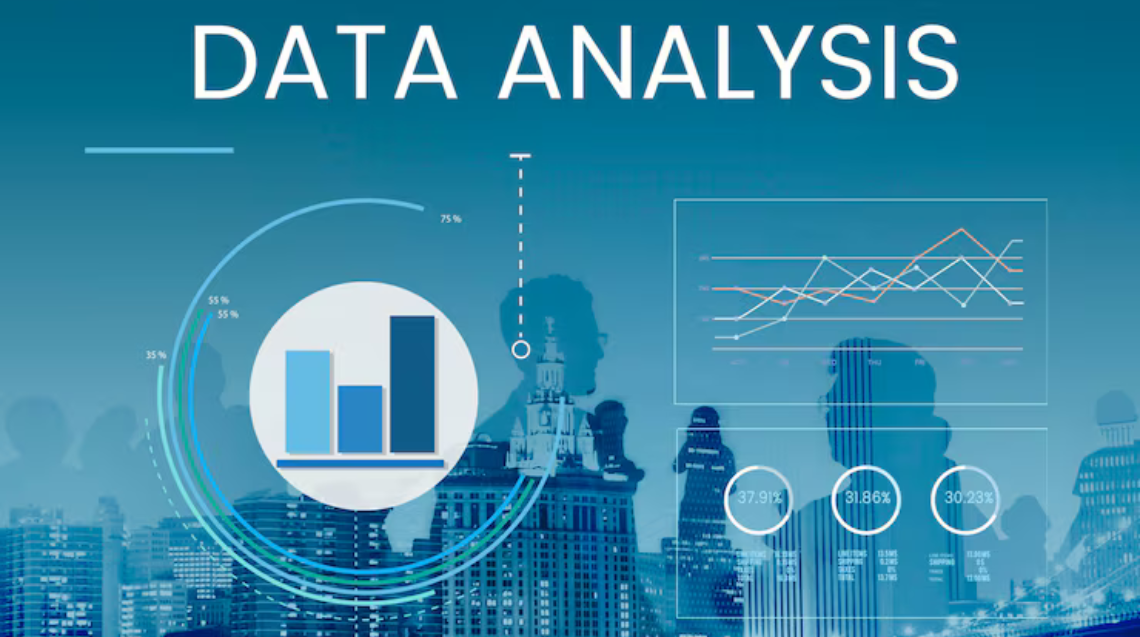The Power of Data Analytics in Driving Business Growth.
In today’s digital-first economy, data is more than just numbers—it’s the lifeblood of modern business. Every click, transaction, and interaction generates valuable information that, when properly analyzed, can unlock powerful insights. This is where data analytics comes into play. It’s the science—and art—of transforming raw data into actionable intelligence.
Whether you're a startup trying to understand your customers or a multinational corporation optimizing global operations, data analytics is the key to smarter decisions, greater efficiency, and sustained growth. In this blog, we’ll explore the full spectrum of data analytics, its strategic importance, tools, applications, and how it’s reshaping the future of business.
What Is Data Analytics?
At its core, data analytics involves collecting, organizing, and analyzing data to discover useful information, draw conclusions, and support decision-making. It’s a multidisciplinary field that blends statistics, computer science, and domain expertise.
Types of Data Analytics
- Descriptive: Understand what happened (e.g., monthly revenue reports)
- Diagnostic: Understand why it happened (e.g., investigating drop in app engagement)
- Predictive: Forecast future outcomes (e.g., anticipating customer churn)
- Prescriptive: Recommend actions (e.g., suggesting optimal marketing spend)
Why Data Analytics Matters for Business Growth
Data analytics isn’t just a technical function—it’s a strategic enabler. Here’s how it drives growth across key dimensions:
-
Informed Decision-Making: Data-driven decisions are more accurate, timely, and impactful.
Instead of relying on intuition or outdated reports, leaders can use real-time dashboards and predictive models to guide strategy.
Example: A telecom company uses customer usage data to identify which plans are most popular and which features are underutilized. This insight helps them redesign packages to better meet customer needs and increase retention.
-
Operational Efficiency: Analytics helps organizations streamline operations by identifying inefficiencies, redundancies, and areas for improvement.
Example: A logistics firm uses route optimization algorithms to reduce fuel consumption and delivery times. By analyzing traffic patterns and delivery windows, they save millions annually and improve customer satisfaction.
-
Enhanced Customer Experience: Understanding customer behavior is crucial for personalization. Analytics enables segmentation, targeting, and tailored experiences that boost loyalty and lifetime value.
Example: E-commerce platforms track browsing behavior, purchase history, and cart abandonment rates to personalize product recommendations and email campaigns.
-
Innovation and Product Development: Analytics reveals unmet needs and emerging trends, guiding innovation. Companies can test hypotheses, validate ideas, and iterate faster.
Example: A fitness app analyzes user feedback and workout patterns to introduce new features like AI-based coaching and gamified challenges.
-
Risk Management and Compliance: From fraud detection to regulatory compliance, analytics helps organizations stay secure and accountable.
Example: Insurance companies use predictive models to assess claim risk and detect fraudulent activity, saving billions in payouts.
Tools and Technologies in Data Analytics
The analytics ecosystem is vast, with tools ranging from simple spreadsheets
to advanced machine learning platforms. Here’s a breakdown:
| Tool / Platform |
Purpose |
Notable Features |
| Microsoft Power BI |
Business intelligence |
Real-time dashboards, data connectors |
| Tableau |
Visual analytics |
Interactive charts, storytelling features |
| Python |
Data science & ML |
Libraries like Pandas, NumPy, scikit-learn |
| R |
Statistical computing |
Advanced modeling, data visualization |
| SQL |
Data querying |
Structured data manipulation |
| Excel |
Basic analytics |
Pivot tables, formulas, charts |
| Apache Spark |
Big data processing |
Distributed computing, real-time analytics |
| Google BigQuery |
Cloud analytics |
Fast SQL queries on large datasets |
| Cloud Platforms (AWS, Azure, GCP) |
Scalable infrastructure |
Storage, processing, analytics at scale |
Building a Data-Driven Culture
Technology alone isn’t enough. To truly harness analytics, organizations must cultivate a data-driven mindset across all levels.
Key Elements of a Data-Driven Culture:
- Leadership Commitment: Executives must champion data initiatives and lead by example.
- Employee Empowerment: Teams should be trained to interpret data and use it in daily decision-making.
- Data Literacy: Everyone—from marketing to HR—should understand basic analytics concepts.
- Collaboration: Cross-functional teams must share insights and align on goals.
- Governance: Clear policies ensure data quality, privacy, and ethical use.
Example: Google encourages experimentation and measurement in every project.
Teams use A/B testing, user analytics, and feedback loops to refine products continuously.
Key Strategies for Building a Data-Driven Culture
- Leadership Intervention & Commitment: Leaders must actively champion data initiatives, clearly communicate their importance, and visibly use data in decision-making.
- Clean and Accessible Data: Invest in data quality by cleaning and structuring data, using tools or external expertise as needed. Broader availability supports informed decision-making across teams.
- Aim for democratized data access: Broader availability supports informed decision-making across teams.
- Data Literacy and Empowerment: Regularly invest in training to improve employees’ ability to interpret and use data for better decisions.
- Encourage Critical Thinking: Not just following data blindly, but integrating expertise and judgment. Consider gamified or experiential learning (e.g., competitions, workshops) to boost engagement.
Case Studies: Analytics in Action
-
Amazon – Predictive Inventory Management:
By analyzing over 1.5 billion transactions daily, Amazon predicts demand for 70% of its SKUs weeks in advance.
This ensures optimal stocking across 175+ fulfillment centers, reducing delivery times by up to 30% and cutting warehousing costs.
-
Starbucks – Location Intelligence:
Starbucks evaluates foot traffic, demographics, and income data from over 100 million customer transactions annually.
Using GIS mapping and predictive analytics, it identifies profitable store locations, contributing to its expansion to 35,000+ stores globally.
-
Uber – Dynamic Pricing:
Uber processes 15 million ride requests per day, adjusting fares in real-time based on demand, traffic, and weather.
This surge pricing model has improved driver availability by 80% during peak times while balancing supply and demand.
-
Netflix – Content Strategy:
With 270+ million subscribers, Netflix tracks viewing time, completion rates, and ratings for every show.
For example, its data-driven insights led to renewing shows like Stranger Things, which garnered 1.4 billion watch hours in 2022.
This reduces investment risk and boosts engagement.
Advanced Analytics Techniques
Beyond basic reporting, techniques like Machine Learning, NLP, Time Series, and Clustering provide predictive and prescriptive insights.
-
Machine Learning (ML): ML models learn from data to make predictions or classifications.
Use Case: Predicting customer churn based on usage patterns and support interactions.
-
Natural Language Processing (NLP): Analyzes text data from reviews, social media, and support tickets.
Use Case: Sentiment analysis to gauge customer satisfaction.
-
Time Series Analysis: Used for forecasting trends over time, such as sales, stock prices, or website traffic.
Use Case: Forecasting monthly revenue based on historical data.
-
Clustering and Segmentation: Groups similar data points to identify patterns or customer segments.
Use Case: Segmenting users based on behavior for targeted marketing.
Challenges in Data Analytics
Common challenges include data silos, privacy concerns, skill gaps, and overreliance on tools.
Overcoming these requires centralized data systems, ethics, training, and human judgment.
-
Data Silos – When data is scattered across departments or systems, it’s hard to get a unified view.
💡 Solution: Implement centralized data warehouses and integration tools.
-
Privacy & Ethics – Collecting and using data responsibly is critical. Misuse can damage reputation and cause legal issues.
💡 Solution: Adopt transparent data policies, comply with GDPR, and prioritize user consent.
-
Skill Gaps – Many organizations lack skilled data professionals.
💡 Solution: Invest in training, hire data scientists, and promote data literacy across teams.
-
Overreliance on Tools – Analytics tools are powerful, but human judgment is irreplaceable.
💡 Solution: Use tools to support—not replace—strategic thinking.
The Future of Data Analytics
-
AI-powered Augmented Analytics
By 2026, 65% of analytics tasks are expected to be automated with AI-driven tools,
making insights accessible to non-experts. (Source: Gartner)
-
Real-Time Analytics
Over 80% of enterprises say real-time insights will be critical to customer experience by 2027,
enabling instant responses to market and behavioral changes. (Source: IDC)
-
Edge Analytics at IoT level
By 2030, more than 50 billion IoT devices will generate data, with
75% of enterprise data processed at the edge rather than in centralized clouds. (Source: Statista & Gartner)
-
Ethical AI
With 72% of consumers concerned about data privacy, organizations must prioritize
bias-free, transparent AI systems to maintain trust and comply with global regulations. (Source: PwC Survey)
-
Data Democratization
By 2030, 70% of employees in large organizations will use self-service analytics tools daily,
empowering decision-making beyond data science teams. (Source: McKinsey)
Strategy and Culture Integration for AI Success
Integrating strategy and culture is crucial for AI success in data-driven organizations.
When aligned, AI initiatives move beyond isolated projects to deliver measurable, scalable business value.
Strategy provides objectives, direction, and frameworks, while culture ensures adoption, trust, and continuous innovation.
A Strategically Integrated Approach Means:
- Business Alignment: AI projects are tied to business goals and long-term objectives, ensuring relevance and leadership support.
- Roadmaps & Governance: Clear frameworks prevent AI from stalling in pilot phases and help manage risks and regulations.
- Cultural Adoption: Collaboration, data literacy, and openness to change empower employees at all levels to leverage AI effectively.
With this integration, organizations avoid silos and fragmented efforts—AI becomes a core part of workflows,
not just a technical add-on. A culture that promotes innovation, learning, and shared responsibility builds trust in AI.
Backed by strategic clarity (why, what, and how AI is used), organizations achieve sustainable transformation,
enhancing decision-making, operational excellence, and competitive advantage.
Without integration, organizations risk wasted investment, poor adoption, and suboptimal outcomes—as seen
in the high rate of abandoned AI projects due to lack of alignment. True success occurs only when people
shape the use of AI guided by strategy, within a culture that values data and innovation.
Final Thoughts
Data analytics is no longer a luxury—it’s a necessity. It empowers organizations to understand their environment, anticipate change, and act with precision. From improving customer experience to driving innovation, the possibilities are endless.
But the true power of analytics lies not in the tools or algorithms—it lies in the mindset. Businesses that embrace a culture of curiosity, experimentation, and continuous learning will thrive in the data-driven future.
So whether you're just starting your analytics journey or looking to scale, remember: data is your compass. Use it wisely, and it will guide you to growth, resilience, and success.

